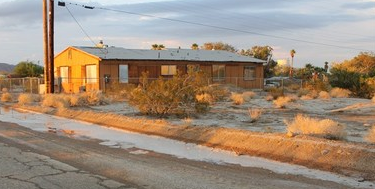
By Miriam Raftery
July 24, 2012 (Ocotillo) – On Friday the 13th of July, foaming floodwaters rushed through the town of Ocotillo, leaving a white chemical residue behind on lawns, streets, and the surrounding desert floor.
Despite numerous complaints to federal, state and local officials, however, nothing has been done to test the residue or correct a drainage pattern altered by Pattern Energy’s construction at the adjacent Ocotillo Express industrial wind site on Bureau of Land Management property.
The flooding is the latest in a long string of problems tied to Pattern and its subcontractors, which residents say have exhibited a pattern of breaking rules that protect public health and safety, with seemingly no serious consequences.
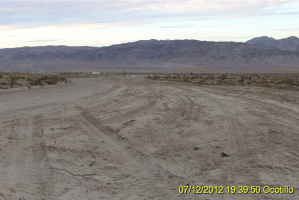 The company is building 42 miles of new roads—many of them far wider than the 20 feet (36 including construction phase) authorized by the federal government in official project documents. Some are over 100 feet wide. Far more of the desert is being disturbed than the one or two percent that Pattern claimed. So why has nothing been done?
The company is building 42 miles of new roads—many of them far wider than the 20 feet (36 including construction phase) authorized by the federal government in official project documents. Some are over 100 feet wide. Far more of the desert is being disturbed than the one or two percent that Pattern claimed. So why has nothing been done?
Pattern has been cited twice by Imperial County for violating dust mitigation 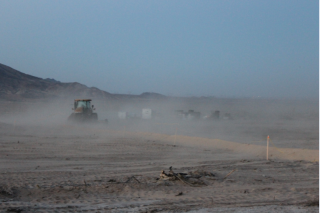 requirements. Yet the abuse continues. (View a video of dust at the construction site.)
requirements. Yet the abuse continues. (View a video of dust at the construction site.)
Witnesses have sent ECM dozens of date-stamped photos documented repeated massive dust clouds emanating from the site in an area where deadly Valley Fever spores and already high asthma rates are serious concerns.
Residents have also provided evidence of filthy water flooding turbine e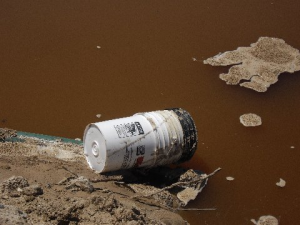 xcavation holes after the recent storm. One hole, measuring 285 feet in diameter was filled with dark water and white foamy sludge floating on top , a tipped over bucket beside the water’s edge---all atop the only source of drinking water for the towns of Ocotillo, Coyote Wells, and Nomirage—a federally protected 82-square mile sole-source aquifer.
xcavation holes after the recent storm. One hole, measuring 285 feet in diameter was filled with dark water and white foamy sludge floating on top , a tipped over bucket beside the water’s edge---all atop the only source of drinking water for the towns of Ocotillo, Coyote Wells, and Nomirage—a federally protected 82-square mile sole-source aquifer.
ECM has contacted numerous official channels seeking answers. Most agencies did not respond. The Bureau of Land Management offered up a tepid respons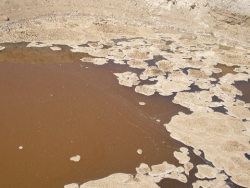 e, explaining various drainage requirements, but failed to provide any remedies for Ocotillo residents who fear toxic contamination of their town and their drinking water, destruction of the desert they love, and potential long-term health problems from Pattern’s wind energy project.
e, explaining various drainage requirements, but failed to provide any remedies for Ocotillo residents who fear toxic contamination of their town and their drinking water, destruction of the desert they love, and potential long-term health problems from Pattern’s wind energy project.
Jim Pelley, an award-winning ECM photographer, engineer and resident of Ocotillo, traced the July 13 flooding upstream from the town’s streets and found dirt coming from the project site, where berms creating during road-grading were “blocking water, streambeds, and this 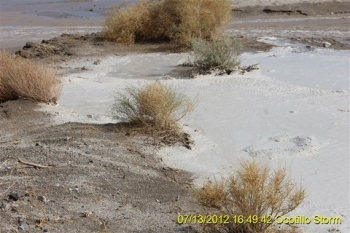 dirt is being carried downstream into our streets,” he told ECM.
dirt is being carried downstream into our streets,” he told ECM.
“Instead of being carried across the desert in a fan effect, an even load, it’s being channeled into areas where it is creating rivers," said Pelley. "It definitely flowed down the street and into people’s yards…Some places it looked like a foam.”
Pelley is angered that Pattern has refused to take responsibility. “The day after the flood, instead of mopping up and cleaning up their mess, they went out there and dug another turbine hole,” while the earth was soft from the rains, “just taking advantage of the situation.”
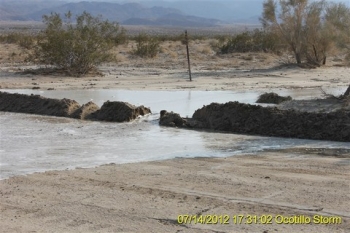 Attorney William Pate, who owns property in Ocotillo, sent a complaint on July 16 asking for civil enforcement to revoke Pattern’s permits for the project.
Attorney William Pate, who owns property in Ocotillo, sent a complaint on July 16 asking for civil enforcement to revoke Pattern’s permits for the project.
He contacted the U.S. Environmental Protection Agency, U.S. Army Corps of Engineers, and the Colorado River Basin Regional Water Quality Control Board. Pate alleges violations of the Clean Water Act, Clean Drinking Water Act, and National Pollutant Discharge Elimination System requirements.
“In the face of multiple lawsuits in federal and state court, and insufficient wind to allow for wind energy development, the developer has proceeded to begin construction of over 40-plus miles of new `access’ roads across previously undisturbed desert in a `limited’ use desert conservation area,” Pate says of the 112-turbine project on 12,436 acres of Bureau of Land Management public p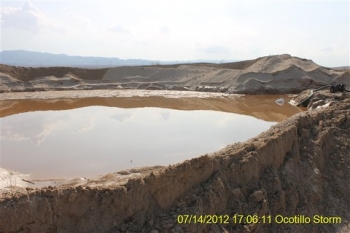 roperty. Pate states that on July 13, “a moderate, one-year rain even occurred, which established overwhelming evidence of the hydrology issues caused by the developers’ work.”
roperty. Pate states that on July 13, “a moderate, one-year rain even occurred, which established overwhelming evidence of the hydrology issues caused by the developers’ work.”
Pate states that in addition to unauthorized creation of berms from road grading, “water has also been improperly channeled into the holes dug for turbine foundations and illegally eroded excavated material was discharged into waters of the U.S. and caused mud and dirt sediment.” Undisturbed portions of the same drainage area further west had no flooding, however, clearly establishing that Pattern’s activities caused.
Astoundingly, he observes that “a hydrologic assessment was not included as part of the Environmental Impact Statement.”
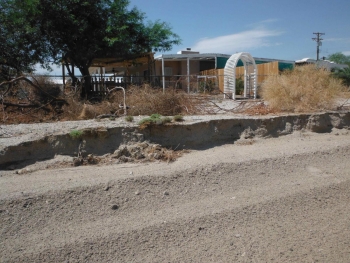 David Player, who lives on Boundary Avenue in Ocotillo, also foiled a formal complaint to various agencies confirming that “the natural waterways hae been altered so that S-2 and our entire town was flooded.” Waters were “higher than they have been in the past” and a white powdery substance was deposited around homes and streets in large quantities.
David Player, who lives on Boundary Avenue in Ocotillo, also foiled a formal complaint to various agencies confirming that “the natural waterways hae been altered so that S-2 and our entire town was flooded.” Waters were “higher than they have been in the past” and a white powdery substance was deposited around homes and streets in large quantities.
“My property almost didn’t make it through this—we had two feet of running water down the street,” said Player, who included photos of the damage.
“Is it toxic? Is it safe for my kids to be around or any residents to come in contact with?” he asked. “how about our town’s sole source of drinking water? Has it been compromised by pollutants fromt his project? As residents, we are EXTREMELY concerned about our HEALTH, SAFETY and WELL-BEING,” he stressed. He further voiced anger that “it appeared there was NO plan in place for the immediate clean-up or mitigation of drainage that was happening on that storming day. What will be different next time,” he asked, “or are we in for 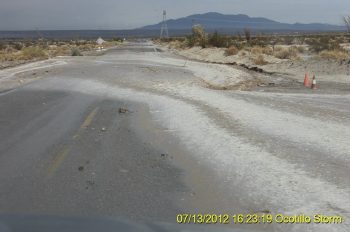 it much next time?”
it much next time?”
ECM contacted numerous agencies to ask what the white chemical material is, whether it is toxic, and whether cleanup and/or a project shut-down will occur to protect the public health. We also inquired about pollution of the aquifer, excessive road widths and dust.
Only two agencies responded. The EPA referred us to the Imperial County Department of Toxic Substances Control. ECM has contacted that department and is still awaiting a response.
Steve Razo at the BLM responded on July 20 that “We have not received any complaints for the public about this subject and are unaware of the white substance,” which contradicts emails forwarded by multiple residents who did submit complaints.
Razo insisted that “the storm water pollution plan is being followed and monitored by BLM” although residents photographing the site daily dispute that claim. Razo added that to prevent erosion the agency uses “soil binders that meet standards and are approved by BLM” as well as “dispersion devices such as rock to disperse the energy” in streambeds, along with other measures such a sediment bags. He added that when pumping water from turbine foundation holes, a suction hose was suspended “in such a way to limit the amount of sedimentation that would be drawn through the hose.”
He added, “There have been no citations or violations from the County.”
He pointedly did not respond to multiple questions about toxicity and identity of the white substance, or what will be done to clean up the Ocotillo area and protect residents and wildlife such as burrowing owls from future flooding and pollution.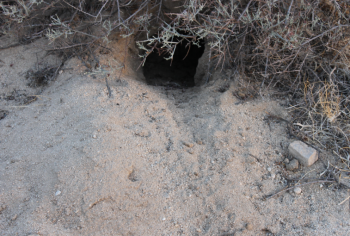
So just what is the white substance? Pattern has repeatedly refused to respond to ECM inquiries about its Ocotillo Express project.
Razo from the BLM, in a July 24 followup email to ECM, claimed that the white residue “appears to be natural fines (sand silt and clay) that were washed up by rainwater. A BLM on-ground monitor sifted by hand several clumps of various samples and all dissolved into fine dirt and silt,” he said, adding, “there was no evidence of any oily texture of smell. The alkalinity of the soil is likely the cause of the frothing/white wash that has been observed.”
Although the BLM has declined to actually test the material, Razo insisted there is no toxicity to the aquifer or to burrowing animals and, that no loss of stored product occurred at the project site. No soil samples will be tested unless there is confirmation of a toxic leak, he indicated.
But long-time area residents say they have never seen white residue or frothing in any past storm. Some suggest a whitewash by 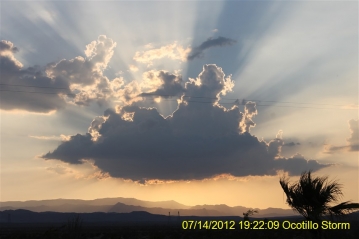 authorities.
authorities.
“I can honestly say in the 8 years I have lived out here I have never seen this white stuff on the ground after a storm and I have seen some pretty good storms out here,” said Pelley.
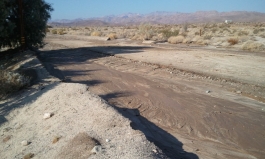 Robert Dallezotte responded, “I have not seen this white stuff either.” He forwarded photos taken on July 13, just after the storm east of Jackson’s RV park near Shell Canyon road and Opal. “There is zero construction activity around this location and from what I have seen all washes were very clean after the storm.”
Robert Dallezotte responded, “I have not seen this white stuff either.” He forwarded photos taken on July 13, just after the storm east of Jackson’s RV park near Shell Canyon road and Opal. “There is zero construction activity around this location and from what I have seen all washes were very clean after the storm.”
Similarly, Joe Asciutto stated, “The Nomirage area of Ocotillo, CA did not have residual “white stuff” after the rains either. And, obviously, none of the run-off from the wind turbine construction flowed through that area. Therefore to claim that it is natural, is BS.”
If it’s not natural, what might it be?
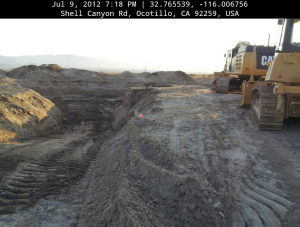 The most likekly possibility is that the substance is a chemical added to water to suppress dust, since dust suppression has been a contentious issue at the project site. Massive amounts of water have been sprayed to keep dust down, possibly mixed with a chemical compound commonly used for such purposes. But Pattern has refused to confirm which dust suppression chemical was used in Ocotillo.
The most likekly possibility is that the substance is a chemical added to water to suppress dust, since dust suppression has been a contentious issue at the project site. Massive amounts of water have been sprayed to keep dust down, possibly mixed with a chemical compound commonly used for such purposes. But Pattern has refused to confirm which dust suppression chemical was used in Ocotillo.
One such product used for dust suppression at other large desert energy projects is called “Gorilla Snot.” (http://www.gorilla-snot.com/). A vinyl copolymer emulsion, it uses nanotechnology to bind soils and control dust and erosion. According to the materials safety data sheet, Gorilla Snot is a milky white and turns transparent once cured. (Residents report that the white substance has now turned transparent.)
Gorilla Snot is not listed as a carcinogen but can cause eye and skin irritation, as well as irritation to the respiratory tract if inhaled. Decontamination is advised for all protective equipment worn by firefighters who use the product. Moreover the guidelines advise users to “prevent spilled material from entering sanitary swers, storm stewers, drainage systems and from entering bodies of water….” If a spill occurs, material should be removed in metal containers, areas such be flushesd with water spray and users shoud “water contaminated property (e.g. automobiles) quickly before the material dries. For large spills, recover spilled material with a vacuum truck.”
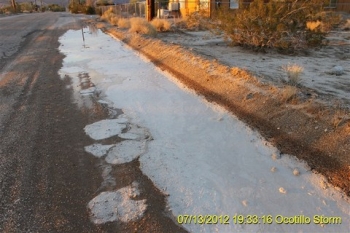 If allowed to dry, “thermal decomposition may form: Acetic acid and acrolein” the paper warns. “Thermal decomposition may produce various hydrocarbons and irritating acrid vapors.
If allowed to dry, “thermal decomposition may form: Acetic acid and acrolein” the paper warns. “Thermal decomposition may produce various hydrocarbons and irritating acrid vapors.
No decontamination has been done in Ocotillo. So what happens to children playing or pets laying on yards covered in a soil binder or dust suppression chemical, if that in fact is what the substance is? Will there be damage to cars or other items exposed to the substance?
There is another troubling fact listed on the materials data safety sheet. “This material will not burn unless it is evaporated to dryness.” It adds, “When dried polymer burns, water, carbon dioxide, carbon monoxide and smoke are produced.”
What happens if someone strikes a match, drops a cigarette butt or lights up a barbecue in Ocotillo? Nobody knows.
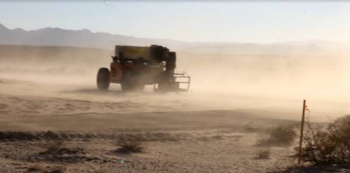 There is a Catch-22 element to this story. While residents now fret about a chemical residue likely resulting from dust suppression efforts, prior to the storm much criticism focused on project developer Pattern Energy and its subcontractors for not doing enough to control dust.
There is a Catch-22 element to this story. While residents now fret about a chemical residue likely resulting from dust suppression efforts, prior to the storm much criticism focused on project developer Pattern Energy and its subcontractors for not doing enough to control dust.
Pattern has been cited twice for violating dust mitigation requirements. The last time was June 16. Yet still, photos and videos reveal a continual onslaught of dust from the project polluting the once-pure desert air.
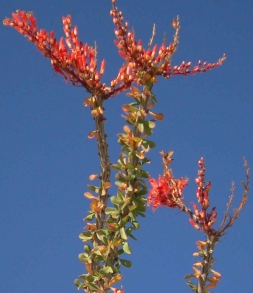 Lyle Brecht observed that he “saw the huge dust storm covering the whole sky over the OWEF (project) site,” adding that the known health impacts and costs of disturbing the fragile biological soil crusts on this desert site were not calculated in project’s the Final Enviornmental Impact Statement or Environmental Impact Report-a seemingly glaring oversight on the part of federal officials. A recent report by the Soil Science Society of America concluded that recovery of biological soil crusts can take up to several thousands of years. http://www.soils.org/story/2012/jul/wed/sneak-peek-new-research-reveals-desert-ecosystems-depend-on-soil-crusts.
Lyle Brecht observed that he “saw the huge dust storm covering the whole sky over the OWEF (project) site,” adding that the known health impacts and costs of disturbing the fragile biological soil crusts on this desert site were not calculated in project’s the Final Enviornmental Impact Statement or Environmental Impact Report-a seemingly glaring oversight on the part of federal officials. A recent report by the Soil Science Society of America concluded that recovery of biological soil crusts can take up to several thousands of years. http://www.soils.org/story/2012/jul/wed/sneak-peek-new-research-reveals-desert-ecosystems-depend-on-soil-crusts.
Pattern was required under mitigation requirements to control dust at the project site.
Pelley began documenting dust problems at the site starting May 11 and started filing complaints about the dust May 17. “I have called the APCG many times reporting dust,” he wrote on June 14, including photos of an access road being built with little or no water on the ground. “I don’t understand why this is not taken seriously…I am very concerned for my family’s health and others for the possibility of us contracting Valley Fever, a deadly disease.”
He suggested that monitors have been turning a blind eye to violations. “The monitors that were supposed to be making sure this wasn’t happening were right in the area but yet the dust continued,” he wrote, adding that often no water trucks have been at the site. Winds from east to west toward the town “blow directly toward the town, the community park where kids play and my house,” he complained, noting that he voiced concerns about dust at public meetings before the project was approved and was “reassured that the dust would be controlled. Obviously it is not…”
He pleaded, “Please help with this ongoing nightmare. It is out of control. This is a perfect example of the negative impacts of Fast Tracking.”
On June 15, he followed up to state that whenever he showed up at the site to take photos, “When the workers notice I am there, they attempt to get extra water trucks in an effort to control the dust…When no one is around, dust doesn’t seem to concern them at all.” Pelley has hidden behind a ridgeline before dawn to catch photos of apparent violations of the dust mitigation, but the APCG has insisted it can’t enforce actions based on photos—only inspectors on site.
But Pelley charges, “In some of my pictures there is a monitor at the site doing absolutely nothing to stop the trucks that are creating dust.” He asked, “Can you explain to me why these contractors are allowed to break the law and your department is not doing anything about it?”
Pattern was cited for dust mitigation violations on June 15, its second violation. Since then, problems have continued unabated.
On June 19, Pelley notified Frank Garcia at Imperial County’s Air Pollution Control District that he saw “absolutely no sign of water on the partially developed turbine access road.”
Yesterday, July 23, Pelley observed, “I notice the workers started at or before 5:30 am…I could see the lights and the dust. I called the Air Pollution control but then again they were not open, this is the same problem on weekends when we report dust. I don’t understand why Blattner Energy (a subcontractor) is still allowed to make dust and very little is being done to stop it…There should be an air pollution control monitor on site full time…Why are they not monitoring this dangerous health issue?”
On July 23, Edie Harmon, an area resident who has won national awards for her environmental activism to protect low -income communities, complained on a listserve of Ocotillo issues that “mitigation measures related to air pollution and dust control continue to be more than woefully inadequate and apparently unenforceable in any meaningful way."
 In addition to not being healthy for humans, Harmon said, "the amount of dust will have adverse impacts on animal life and vegetation as it gets covered with dust, thereby reducing forage quality…Why don’t these issues ever get resolved?” she asked. “The BLM manged public land and the residents of SW Imperial County should not be considered a National Sacrifice Area.”
In addition to not being healthy for humans, Harmon said, "the amount of dust will have adverse impacts on animal life and vegetation as it gets covered with dust, thereby reducing forage quality…Why don’t these issues ever get resolved?” she asked. “The BLM manged public land and the residents of SW Imperial County should not be considered a National Sacrifice Area.”
Complaints on other issues have similarly fallen on deaf ears. ECM has received photo documentation of roads far wider than the 20 feet (36 feet temporary disturbance area) authorized in the Final Environmental Impact Report, including one measuring a full 110 feet wide.
Native American tribes have lodged complaints that Pattern’s pre-project archaeological and cultural resource assessment was inadequate, noting that the site was known as the “Valley of the Dead” for their ancestors. Tribes paid to bring Institute of Canine Forensics search dogs to the site, specially trained to locate ancient human remains.
Working in just a small section of the 12,500 acre site, the dogs swiftly alerted on approximately 50 presumed cremation sites—far in excess of the six identified by Pattern. Tribes have asked the BLM to require an assessment of the full site, but the government has refused. As early as February, Viejas Chairman Anthony Pico wrote a letter to President Obama asking that the project be stopped to preserve Native Americans' cultural heritage, but the letter was never answered.
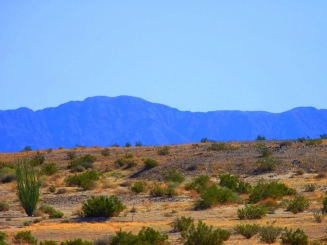 Pattern has thus far voluntarily avoided the presumed burial/cremation sites, but has refused to acknowledge them as cultural resource sites and has questioned the validity of the findings. Meanwhile excavation continues at areas not yet searched, while Native Americans worry that their ancestors’ remains are being desecrated. They also decry the despoiling of ancient artifacts and sacred landscapes.
Pattern has thus far voluntarily avoided the presumed burial/cremation sites, but has refused to acknowledge them as cultural resource sites and has questioned the validity of the findings. Meanwhile excavation continues at areas not yet searched, while Native Americans worry that their ancestors’ remains are being desecrated. They also decry the despoiling of ancient artifacts and sacred landscapes.
Five lawsuits have been filed seeking to halt the project but thus far, none of the cases have been heard. Plaintiffs include environmental groups, the Quechan Indian tribe, and citizens' groups.
If the project is not stopped, what might residents have to look forward to once construction is completed?
If Pattern is allowed to divert floodwaters through the town, emit plumes of dust and build roads triple the size authorized with virtually no consequences, will the company be responsible in responding to future potential issues such as noise complaints or health problems such as headaches, sleeplessness, heart palpitations or ear pain frequently cited by neighbors of industrial wind development? Or assure accurate body counts of birds and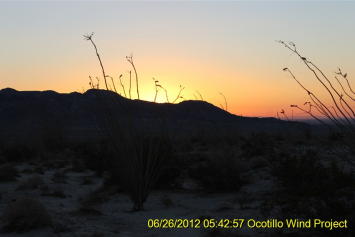 bats will be conducted, or steps taken to minimize wildlife kills?
bats will be conducted, or steps taken to minimize wildlife kills?
Based on the track record thus far, neighbors appear to have legitimate causes for concern about the future health, safety and wellbeing of their community and the surrounding once-beautiful desert ecosystem.
Update 2016: The manufacturer of Gorilla Snot has contacted ECM and says their company did not apply Gorilla Snot in Ocotillo. We have asked for clarification as to whether a subcontactor may have done so, or whether a different product was applied.







Comments
I feel horrible for these
I feel horrible for these people. Ocotillo may not be the most glamorous town in the world, but it enjoys an enviable solitude and stunningly beautiful desert surroundings.
That it could--will--be ruined for idiotic reasons by politicians thousands of miles away--people who will never see the area and don't give a damn about the residents--is deeply upsetting.